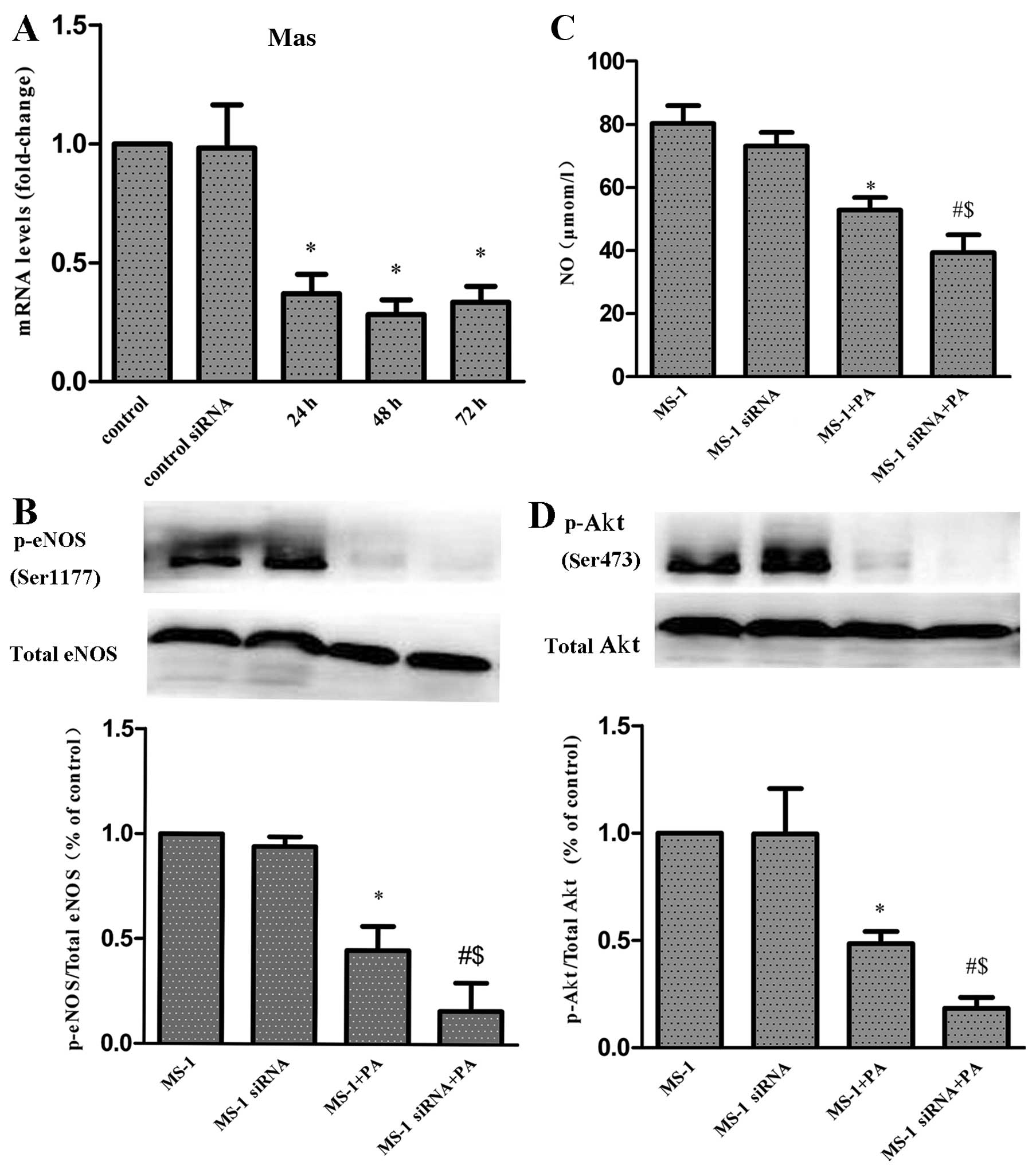|
1
|
Bearer EL and Orci L: Endothelial
fenestral diaphragms: a quick-freeze, deep-etch study. J Cell Biol.
100:418–428. 1985. View Article : Google Scholar : PubMed/NCBI
|
|
2
|
Lammert E, Cleaver O and Melton D:
Induction of pancreatic differentiation by signals from blood
vessels. Science. 294:564–567. 2001. View Article : Google Scholar : PubMed/NCBI
|
|
3
|
Johansson M, Mattsson G, Andersson A, et
al: Islet endothelial cells and pancreatic beta-cell proliferation:
studies in vitro and during pregnancy in adult rats. Endocrinology.
147:2315–2324. 2006. View Article : Google Scholar : PubMed/NCBI
|
|
4
|
Zhu W, Zhong C, Yu Y, et al: Acute effects
of hyperglycaemia with and without exercise on endothelial function
in healthy young men. Eur J Appl Physiol. 99:585–591. 2007.
View Article : Google Scholar : PubMed/NCBI
|
|
5
|
Tikellis C, Wookey PJ, Candido R, et al:
Improved islet morphology after blockade of the renin- angiotensin
system in the ZDF rat. Diabetes. 53:989–997. 2004. View Article : Google Scholar : PubMed/NCBI
|
|
6
|
Yuan L, Li X, Li J, et al: Effects of
renin-angiotensin system blockade on the islet morphology and
function in rats with long-term high-fat diet. Acta Diabetol.
50:479–488. 2013. View Article : Google Scholar : PubMed/NCBI
|
|
7
|
Li X, Yuan L, Xu G, et al: Effect of renin
angiotensin system blockade on the islet microvessel density of
diabetic rats and its relationship with islet function. J Huazhong
Univ Sci Technolog Med Sci. 29:684–688. 2009. View Article : Google Scholar : PubMed/NCBI
|
|
8
|
Donoghue M, Hsieh F, Baronas E, et al: A
novel angiotensin-converting enzyme-related carboxypeptidase (ACE2)
converts angiotensin I to angiotensin 1–9. Circ Res. 87:E1–E9.
2000.
|
|
9
|
Danilczyk U and Penninger JM:
Angiotensin-converting enzyme II in the heart and the kidney. Circ
Res. 98:463–471. 2006. View Article : Google Scholar : PubMed/NCBI
|
|
10
|
Santos RA, Simoes e Silva AC, Maric C, et
al: Angiotensin-(1–7) is an endogenous ligand for the G
protein-coupled receptor Mas. Proc Natl Acad Sci USA.
100:8258–8263. 2003.
|
|
11
|
Benter IF, Yousif MH, Cojocel C, et al:
Angiotensin-(1–7) prevents diabetes-induced cardiovascular
dysfunction. Am J Physiol Heart Circ Physiol. 292:H666–H672.
2007.
|
|
12
|
Shiota A, Yamamoto K, Ohishi M, et al:
Loss of ACE2 accelerates time-dependent glomerular and
tubulointerstitial damage in streptozotocin-induced diabetic mice.
Hypertens Res. 33:298–307. 2010. View Article : Google Scholar : PubMed/NCBI
|
|
13
|
Patel VB, Bodiga S, Basu R, et al: Loss of
angiotensin-converting enzyme-2 exacerbates diabetic cardiovascular
complications and leads to systolic and vascular dysfunction: a
critical role of the angiotensin II/AT1 receptor axis. Circ Res.
110:1322–1335. 2012. View Article : Google Scholar
|
|
14
|
Yuan L, Wang Y, Lu C and Li X:
Angiotensin-converting enzyme 2 deficiency aggravates glucose
intolerance via impairment of islet microvascular density in mice
with high-fat diet. J Diabetes Res. 2013:4052842013. View Article : Google Scholar : PubMed/NCBI
|
|
15
|
Sampaio WO, Henrique de Castro C, Santos
RA, et al: Angiotensin-(1–7) counterregulates angiotensin II
signaling in human endothelial cells. Hypertension. 50:1093–1098.
2007.
|
|
16
|
Lovren F, Pan Y, Quan A, et al:
Angiotensin converting enzyme-2 confers endothelial protection and
attenuates atherosclerosis. Am J Physiol Heart Circ Physiol.
295:H1377–H1384. 2008. View Article : Google Scholar : PubMed/NCBI
|
|
17
|
Bindom SM, Hans CP, Xia H, et al:
Angiotensin I-converting enzyme type 2 (ACE2) gene therapy improves
glycemic control in diabetic mice. Diabetes. 59:2540–2548. 2010.
View Article : Google Scholar : PubMed/NCBI
|
|
18
|
Yuan L, Li X, Xu GL and Qi CJ: Effects of
renin-angiotensin system blockade on islet function in diabetic
rats. J Endocrinol Invest. 33:13–19. 2010. View Article : Google Scholar : PubMed/NCBI
|
|
19
|
Oudit GY, Herzenberg AM, Kassiri Z, et al:
Loss of angiotensin-converting enzyme-2 leads to the late
development of angiotensin II-dependent glomerulosclerosis. Am J
Pathol. 168:1808–1820. 2006. View Article : Google Scholar : PubMed/NCBI
|
|
20
|
Yuan L, Li Y, Li G, et al: Ang(1–7)
treatment attenuates β-cell dysfunction by improving pancreatic
microcirculation in a rat model of type 2 diabetes. J Endocrinol
Invest Dec. 36:931–937. 2013.
|
|
21
|
Bindom SM and Lazartigues E: The sweeter
side of ACE2: physiological evidence for a role in diabetes. Mol
Cell Endocrinol. 302:193–202. 2009. View Article : Google Scholar : PubMed/NCBI
|
|
22
|
Yan C, Kim D, Aizawa T, et al: Functional
interplay between angiotensin II and nitric oxide: cyclic GMP as a
key mediator. Arterioscler Thromb Vasc Biol. 23:26–36. 2003.
View Article : Google Scholar : PubMed/NCBI
|
|
23
|
Burnier M and Zanchi A: Blockade of the
renin-angiotensin-aldosterone system: a key therapeutic strategy to
reduce renal and cardiovascular events in patients with diabetes. J
Hypertens. 24:11–25. 2006. View Article : Google Scholar : PubMed/NCBI
|
|
24
|
Song HJ, Xue WJ, Li Y, et al: Improved
islet survival and funtion with rat endothelial cells in vitro
co-culture. Transplant Proc. 41:4302–4306. 2009. View Article : Google Scholar : PubMed/NCBI
|
|
25
|
Duvillié B, Currie C, Chrones T, et al:
Increased islet cell proliferation, decreased apoptosis, and
greater vascularization leading to beta-cell hyperplasia in mutant
mice lacking insulin. Endocrinology. 143:1530–1537. 2002.PubMed/NCBI
|
|
26
|
Olerud J, Mokhtari D, Johansson M, et al:
Thrombospondin-1: an islet endothelial cell signal of importance
for β-cell function. Diabetes. 60:1946–1954. 2011.
|
|
27
|
Johansson A, Lau J, Sandberg M, et al:
Endothelial cell signalling supports pancreatic beta cell function
in the rat. Diabetologia. 52:2385–2394. 2009. View Article : Google Scholar : PubMed/NCBI
|















